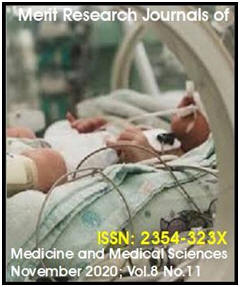
|
|
|
|
|
 |
/ / MRJMMS Home / / About MRJMMS / / Submit Manuscripts / / Call For Articles / / Editorial Board / / Archive / / Author's Guide / /
|
Other viewing option
Search Pubmed for articles by:
Shoaib
M |
Frequency of Complications of Measles Patients Admitted in Paediatric Ward Ayub Teaching Hospital (ATH) Abbottabad |
|||
|
Muhammad Shoaib, Faiqa Ghani, Abdul
Haseeb, Fazal Mabood, Muhammad Siqaf Anjum, |
||||
|
Department of Community Medicine Ayub Medical
College Abbottabad
Received: 01 November 2020 I Accepted:
21 November 2020
I Published: 28 November 2020 I Article ID:
MRJMMS-20-186 |
||||
|
Abstract |
||||
|
Measles is a highly
contagious disease caused by measles virus. Measles was
responsible for millions of deaths annually worldwide before the
introduction of the measles vaccines. The evidence of measles
can be found from the 7th century. It was described by a Persian
physician Rhazes in the 10th century as “more to be dreaded than
small pox. Measles is still common in many developing countries
including Pakistan. Before the availability of measles vaccines,
90% of children were infected before they reached 15 years.
Measles is easily spread from person to person when the infected
person talks, coughs or sneezes, the virus enters the air and
enters the body through mouth and nose. The measles virus lives
on contaminated surfaces and air up to two hours. Symptoms of
measles include fever, skin rashes, cough, runny nose and white
spots inside the mouth. This curriculum based cross sectional
study was designed and selected as a convenient sampling
technique to be carried out Paediatric ward ATH district
Abbottabad. Data was collected by means of an interview-based
questionnaire from the attendants, which was then computed into
statistics using SPSS software and the results were interpreted.
Children from rural areas were affected more as compared to
children from urban areas. Pre-school children are affected more
than school-going children of the same area. Vaccinated children
as predicted were less affected than the non-vaccinated children
because of their vulnerable immune system. Children who received
vitamin A supplementation had a less severe form of the disease
as compared to those children which were deprived of vitamin A
supplementation during or before the infection. In this area,
the measles vaccination rate was way below satisfactory; we need
to improve vaccination of measles and other infectious diseases
at least up to 80%. Children who were brought in a later stage
of the disease had distinctly severe symptoms than those who
were hospitalized in proper time. Measles infection is highly
contagious and the patient must be isolated. |
Merit Research Journals© 2021 || Advertisement | Privacy policy.
